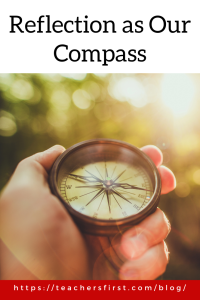Learning without reflection is a waste. Reflection without learning is dangerous.
~Confucious
The complexities of navigating the teaching and learning landscape challenge students and teachers throughout the school year. In changing landscapes, where visual cues may be unreliable, a compass becomes a reliable tool for navigation. A compass determines your orientation and helps you make informed decisions to adjust your course to stay on the right path. Similarly, reflection serves as a compass in teaching and learning, helping educators and students navigate the changing conditions in the classroom and providing direction, clarity, and purpose. Reflection in school allows students and teachers to assess whether they are on the right path or if adjustments are needed. Let’s explore strategies and resources for teachers and students to guide your reflective journey.
Reflective Practices for Teachers:
- Journaling – Maintain a reflective journal to document daily experiences, insights, and challenges in the classroom. Track your thoughts and professional growth through Penzu (reviewed here).
- Peer Observations – Conduct peer observations by observing other classes and providing constructive feedback to colleagues. Use a Google Form (reviewed here) to share perspectives and insights on the experience.
- End-of-Lesson Reflections – Take a few minutes at the end of each lesson to reflect on what worked well, what could be improved, and any unexpected challenges. This immediate reflection helps in making quick adjustments.
- Data Analysis – Regularly analyze student performance data, assessment results, and other relevant metrics to identify patterns, trends, and areas for improvement in teaching methods. Learn more about using forms and spreadsheets for basic data collection and analysis by viewing the archive of this OK2Ask workshop.
- Post-Professional Development Reflection – After participating in a professional learning opportunity, use a thinking routine (developed by Project Zero, a research center at the Harvard Graduate School of Education) to reflect on what you learned and how you might apply it. For example, you might participate live or watch an on-demand archive of an OK2Ask workshop and then use this learning log to guide your reflection.
- Student Feedback – Seek student feedback through surveys or informal discussions to understand their perspectives on the teaching methods, class environment, and overall learning experience. Get instantaneous feedback with the Vevox survey tool (reviewed here).
Reflective Practices for Students
- Learning Journals – Encourage students to maintain learning journals where they can reflect on their understanding of concepts, challenges faced, and goals for improvement. Voxer (reviewed here) offers a combination of instant voice and text messages for students to journal.
- Self-Assessment – Integrate self-assessment tools into assignments and projects. Use Microsoft Forms (reviewed here) to empower students to evaluate their work, identify strengths, and pinpoint areas for improvement.
- Portfolio Creation – Build portfolios showcasing students’ work over time. Wakelet (reviewed here) provides a tangible way for students to reflect on their growth and achievements throughout the academic year by adding their projects and assignments.
- Exit Tickets – Use exit tickets or short reflections at the end of lessons to gauge students’ understanding, solicit questions, and prompt them to consider what they found most valuable from the day’s lesson. Explore this OK2Ask workshop archive for exit ticket strategies and resources to support classroom instruction.
Just as a compass is indispensable for explorers, reflective practices are invaluable tools for educators and learners. How do you reflect on your teaching practices and empower your students to reflect in the classroom? Please share your experiences and insights in the comments below, and let’s continue this conversation together!


